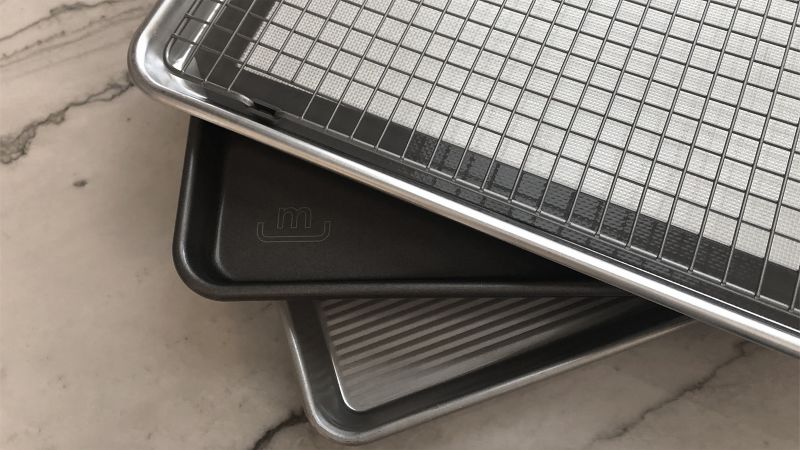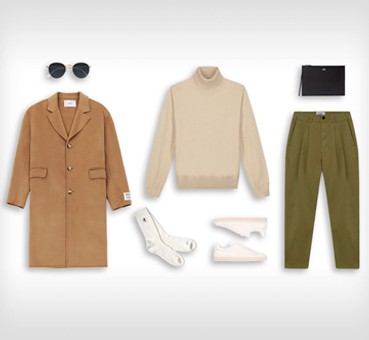Baking sheets — also known as sheet pans — are versatile pieces of bakeware, great for crisping bacon, roasting vegetables, full sheet-pan dinners and even making cookies. They can even serve as a tray for bringing meat out to the grill, or serve as a pot lid in a pinch.
Sheet pans are made with a wide variety of metals, textured surfaces in an array of colors, and with or without non-stick coating. We roasted pounds of carrots and tomatoes, and baked dozens of snickerdoodles on 10 different sheet pans to find the right option for you. Read on to discover the best baking sheet.
Best baking sheet overall
The durable, affordable Nordic Ware uncoated aluminum pan performed as well as more expensive sheet pans in our testing and remained flat without warping even above its rated temperatures.
Best nonstick baking sheet
The attractive Willams-Sonoma has a true non-stick coating, the heft to avoid warping even at high temperatures and is dishwasher safe for easy cleanup.
Best baking sheet for roasting vegetables
The understated Le Creuset carbon steel pan with bright orange handles is well-suited for roasting vegetables and features wide rims that make it a cinch to snag out of the oven.
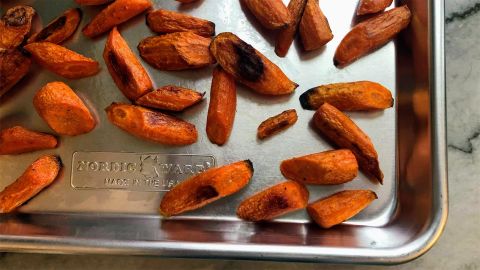
Nordic Ware has earned plenty of accolades online and for good reason: it is an outstanding balance of function and form. And like that slumber party classic, the aluminum sheet pan is light as a feather and stiff as a board. But what made this a no-brainer? It’s one of the least expensive pans we tested.
Nordic Ware’s half sheet is only rated to 400 degrees Fahrenheit, yet it didn’t warp even at 450 degrees Fahrenheit. One possible explanation? The pan’s rim is reinforced internally with galvanized steel wire, which helps it keep its shape.
The bottom of the pan remained flat at high temperatures, which was nice for keeping tomatoes from rolling or cookies from sliding in one direction. The embossed logo on the bottom of the pan is slightly raised, so it did trap some tomato juice and grease.
The sheet pan gave carrots a lovely char and roasted tomatoes without leaving behind blackened skin. Cookies were evenly cooked and golden brown on bottom. There were no hot spots and the rapid cooling of the pan meant the cookies didn’t get too crispy.
The uncoated surface had to be hand-washed; but browned bits came free with water and a soapy sponge. There were a few light scratches and some slight discoloration; but nothing that would impact the performance of the pan.
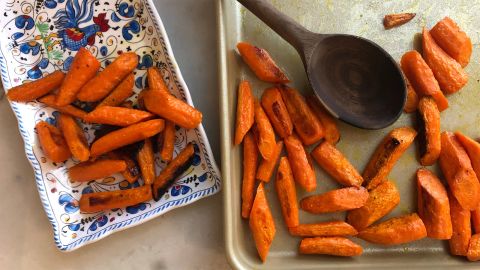
This baking sheet earned top marks for roasting tomatoes and it looked good doing it. The Williams Sonoma sheet pan is dishwasher safe; but the effective nonstick surface means you can easily scrub it clean.
If you’ve been baking for a while, sheet pans that are not dull or shiny silver are hard to resist. The gold aluminized steel pan is sharp – a baking sheet that could go right from the oven to the dining table. Although make sure you have a good trivet, as this pan is a wonder at retaining heat.
The Goldtouch Pro half sheet never warped. It was one of the only models tested that delivered on the substantial feel out of the box. More importantly, it performed excellently — as if it were dialed into all of the tasks it was given. Carrots were evenly browned in the center and sides, while the cookies turned out golden brown without getting too dark on the bottom.
The nonstick coating made it easy to scoop up carrots and tomatoes. While it is dishwasher safe, the surface was clean after only a minute of gentle scrubbing.
The Goldtouch Pro weighs almost three pounds, which adds up once you’re transporting food. We could definitely feel it versus the lighter sheets, and if you find yourself cooking a couple pounds of chicken thighs, it would require some arm strength and definitely two hands to muscle this sheet out of the oven.
The angle of the sides meant that a bit of oil got trapped in the corners when we were roasting carrots and the interior ridge below the rim could make it slightly more difficult to pour off something like bacon grease.
Based on its stellar performance alone, the Williams-Sonoma Goldtouch could easily have been our top choice, if not for its heft and price tag — we think most home cooks and bakers will be happier with several lighter, cheaper baking sheets. But those looking for a sheet pan that can double as a serving tray might find it is worth the added investment.
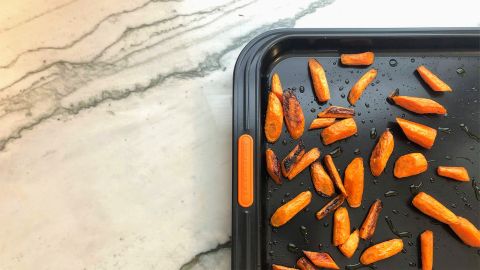
A sleek nonstick pan with wide handles, Le Creuset’s Large Sheet pan — from the brand known for its bakeware and cast iron cookware — is an excellent tool for roasting vegetables.It heats up evenly and has enough style to be the centerpiece on your dining table.
The dark carbon steel pan with orange silicone handles was as distinctive as the bright pink baking sheet from Great Jones. The stylish pan also produced exquisitely roasted vegetables.
Carrots caramelized where they came into contact with the pan and the snickerdoodles were browned on the bottom without being burned. The nonstick surface made it easy to lift out tomatoes and cookies. The surface took only a few passes with a sponge to wipe clean.
At two pounds, this pan is certainly heavy; but the wide rims and silicone inserts made it easier to pick up than some of the rolled rims on pans of equal weight.
The wide rim might also make it harder to stack this pan inside of a cabinet; yet the pan was slightly smaller — 16.75 inches long x 12 inches wide — than the other models we looked at. You may want to opt for a slightly bigger surface area if you’ve trying to make a sheet pan dinner for a family of four.
This pan is hand-wash only and the border between the rim and the bottom of the pan tended to trap food bits and soap that required extra work to clean. The coating scratched on a small section on the rim after it was stacked among other pans.
Lastly, at full retail price, the Le Creuset Large Sheet Pan is the most expensive pan we tested. As we noted with regard to the Williams-Sonoma pan, since you are likely to want to own more than one sheet pan, the cost of a collection could add up quickly.
Baking sheets, or sheet pans, come in three sizes: full, half, and quarter sheets. Full sheet pans are what you see at commercial bakeries and restaurants. A typical full sheet pan is 26 inches long, which you would likely discover was too large to fit in your home oven when you got it home.
Half sheets are what you think of when you see a recipe for a sheet pan dinner. Typically in the neighborhood of 18 inches long, they’ll fit in most cabinets and ovens, and yet still have enough room to spread out your veggies for roasting. Quarter sheet pans are often 13-inches long x 9-inches wide, a bit bigger than a sheet of printer paper. These are handy when you’re looking to roast a few peppers or have a drip tray under steaks defrosting in your fridge.
You may also come across jelly roll pans or cookie sheets in the baking aisle. Jelly roll pans, which get their name from the dessert, are usually sized between quarter and half sheets. Cookie sheets aren’t rimmed like baking sheets, instead typically having one raised side and three flat sides to allow for airflow and your spatula to slide underneath your cookies with ease. Many home bakers use baking sheets for cookies, however, and get great results — so we went the extra mile and made plenty of cookies as part of our testing. Just to make sure we were accurately reproducing the conditions under which these sheets might be used, of course.

We put baking sheets through their paces over several weeks to test their durability. We washed each sheet and then made three different recipes.
We baked snickerdoodle cookies (weighing the dough for each cookie to keep them as uniform as possible) on parchment paper to test for heat distribution and the evenness of browning. We roasted carrots at a high temperature to check for warping, as well as whether or not browned bits stuck to the bottom of the pan during cleaning. We also blistered cherry tomatoes to see if the juice discolored the pan and was easily contained.
We hand-washed with a non abrasive sponge and dish soap or rinsed the sheets and ran them through the dishwasher according to the manufacturer’s recommendation. We noted whether browned bits were hard to remove, if food or soap got trapped underneath the rim, and if the pan was scratched or spotted after cleaning. Once the pans were clean and cool, we placed them flat on the counter to see if any were bent out of shape by heat.
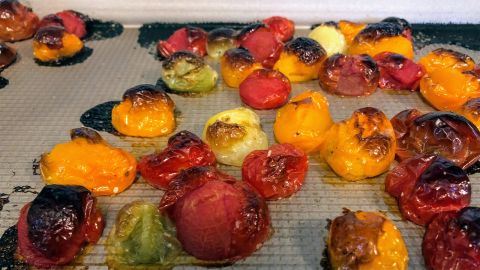
We looked at the design, material, and weight of each baking sheet. We examined textured surfaces to understand if they impacted the cooking process or made it harder to clean. If it was coated with a nonstick material, we also considered whether that had an impact on baking and cleaning. We also lifted each pan out of the oven using only one hand (with a pot holder) to understand if a full, hot pan was difficult to lift or carry around the kitchen.
We then compared the performance of each baking sheet and weighed all of the factors alongside the price to determine which piece of bakeware we’d recommend.
This aluminum baking sheet is beautiful – standing out in a crowd of silver and gold sheet pans. We opted for raspberry (bright pink) – there’s blueberry (blue) and broccoli (green) too – and the nonstick ceramic surface is luminous.
The Holy Sheet (did you get the pun yet?) offered the most cooking space of any pan we tested (slightly bigger than the OXO and Williams Sonoma pans), which matters when you’re trying to squeeze in lots of vegetables in a single layer. At two pounds, it took a bit of wrist strength to lift a loaded pan out of the oven with a single hand.
The sheet pan heated evenly without warping. The carrots and tomatoes were clearly roasted, yet they lacked some of the color and slight char of our favorite models. The non-stick surface was particularly effective with tomato juice on the pan, which didn’t evaporate and leave scorch marks on the surface. The cookies were light and fluffy with a nice chew.
The manufacturer says it’s dishwasher-friendly; but with a non-stick coating it makes sense to wash by hand instead. Oil and dried tomato skin came off the surface without a lot of effort, although there was some faint discoloration after a few trips through the oven.
The Checkered Chef’s stainless steel pan – which comes with a wire rack – looks like a pan you’d expect to find in bakeries and restaurant kitchens. The lack of a stamp or overt branding gave us hope that this could be the kind of baking sheet that people love; but can’t quite remember how it arrived in their kitchen.
That hope was dashed in the first tomato test as the front right half of the pan warped up (it did settle back to flat a few minutes after being removed from the oven). The tomato juice pooled on the other side and there was a lot of scorched skin on the pan, which did loosen with a quick rinse.
The carrots had nice color and the cookies were uniform, if a bit flatter than other batches. This is one of the few pans that was dishwasher safe; but the slight scratch marks on top and scuffs on the sides of the pan after only a few uses raise concerns about durability.
Fans of crispy cookies should take a close look at this sheet pan.
The Oxo half sheet felt substantial out of the box and at just over two pounds, it was one of the heaviest sheet pans we tested. But the stainless steel pan warped significantly on the right side in the oven at 450 degrees Fahrenheit.
As a result, tomato juice pooled on the left side leaving some tomatoes to blacken, while others cooked slightly in the juice. On the plus side, the rolled rims did an effective job of containing the juice.
At lower heats the pan was effective: roasted carrots got a nice bit of char and the snickerdoodles cooked evenly (and were crispier than cookies from other pans). The pan was still hot to the touch for several minutes after it was out of the oven. The heat retention was great for keeping roasted vegetables warm; but we needed to keep a close eye on the cookies to ensure they didn’t get too brown on the bottom.
While the ceramic non-stick surface – an eye-catching gold similar to the Williams Sonoma pan – was easy to clean as scorched bits came up with only a bit of scrubbing, grease did get trapped in the small grooves between the diamond pattern on the bottom of the pan.
This aluminum sheet pan is a nice, in-between weight at a little over 1.8 pounds – solid without feeling difficult to lift. It’s about a half-pound heavier than Nordic Ware’s baking sheet and comes with a higher price tag.
The extra weight didn’t stop the pan from warping at higher temperatures, although it regained its shape as heat dissipated quickly once it was out of the oven. The warping meant that the roasting and char on the tomatoes and carrots was a bit uneven. The sheet pan did brown cookies without burning them.
The uncoated surface showed some scratches and lost some of its sheen after a few rounds in the sink with dish soap and a non-abrasive sponge.
This lightweight aluminum pan rocks an ombre look with the dark gray nonstick coating leading up to the rolled rim above the shiny aluminum sides and bottom of the pan. The slick design yielded mixed results.
The pan warped slightly in the middle at 450 degrees Fahrenheit, its highest rated temperature; but quickly regained its shape as it rapidly cooled. Scorch marks and tomato husks came up easily from the non-stick surface.
It performed better at slightly lower temperatures. The snickerdoodles were consistently browned on the bottom, a sign of even heat distribution. And the carrots had begun to caramelize when we popped them out of the oven.
The pan’s surface came clean with little effort and a few suds. The rolled rim’s construction meant that gunk didn’t get trapped underneath the sides, but some soap did need to be rinsed from underneath the corners where the seal isn’t as tight.
Price does matter when you’re trying to outfit your kitchen. The Chicago Metallic jelly roll pan was one of the most inexpensive pans we tested and would have been a value pick, if not for the outsized performance of the Nordic Ware at roughly the same price point.
As noted by some online reviewers, the label was irritating to remove because it was attached with a lot of adhesive. But since we rinsed and scrubbed all the pans before using them, it was not a dealbreaker.
The aluminized steel pan feels sturdy at 2 pounds and it only warped slightly at 450℉. It distributed heat relatively evenly – the tomatoes had terrific color – and was in the middle of the pack when it came to roasting vegetables and cookies. The raised stamp brand name in the corner of the pan caught a bit of oil grease and thus, required a bit more elbow grease to clean than we would have liked.
We ran it through the dishwasher – the manufacturer says it’s dishwasher safe, but recommends washing by hand (we would too) – and while it came out clean, it also had a few scratches and discoloration in a clear outline of the cherry tomatoes. The underside of the rolled rim tended to trap water and soap when cleaning by hand.
This textured pan felt sturdy – it’s nearly 2.5 pounds of aluminized steel – and had nicely angled sides that were easy to grip. But its performance was less sure footed.
It warped slightly in the middle during the tomato roasting, which made tomato juice collect on the sides of the pan. Our cookies were in danger of overbrowning and our carrots didn’t brown as well as in other sheet pans. The lines of the textured surface required more scrubbing to clean out the grooves properly.
The edges of the pan were scuffed after being stacked with other pans and the roasted tomatoes left the bottom of the pan with a few distinct stains.















































